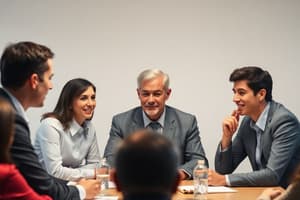Podcast
Questions and Answers
During which stage of team development do conflicts typically arise as team members assert their opinions?
During which stage of team development do conflicts typically arise as team members assert their opinions?
- Forming
- Performing
- Storming (correct)
- Norming
Which leadership style emphasizes participation and encourages group decision-making?
Which leadership style emphasizes participation and encourages group decision-making?
- Laissez-faire
- Autocratic
- Democratic (correct)
- Transactional
What type of conflict arises from personal differences and is typically detrimental to team dynamics?
What type of conflict arises from personal differences and is typically detrimental to team dynamics?
- Goal Conflict
- Relationship Conflict (correct)
- Process Conflict
- Task Conflict
Which conflict resolution strategy involves both sides conceding something to reach a mutually acceptable solution?
Which conflict resolution strategy involves both sides conceding something to reach a mutually acceptable solution?
Which technique involves generating ideas without criticism to encourage free thinking?
Which technique involves generating ideas without criticism to encourage free thinking?
Which role within a team focuses on relationships and support rather than task completion?
Which role within a team focuses on relationships and support rather than task completion?
What leadership style is most effective for routine tasks, focusing on structure and rewards?
What leadership style is most effective for routine tasks, focusing on structure and rewards?
What phenomenon occurs when the desire for harmony within a group leads to poor decision-making?
What phenomenon occurs when the desire for harmony within a group leads to poor decision-making?
Flashcards are hidden until you start studying
Study Notes
Team Dynamics
- Definition: The patterns of interaction and relationships within a team.
- Stages of Team Development:
- Forming: Introduction of team members and initial interactions.
- Storming: Conflict arises as team members assert their opinions.
- Norming: Establishment of norms and cohesion begins.
- Performing: Team works collaboratively towards goals.
- Adjourning: Disbanding after achieving goals.
- Roles within Teams:
- Task Roles: Focus on completing tasks (e.g., initiator, coordinator).
- Maintenance Roles: Focus on relationships and support (e.g., encourager, mediator).
- Trust and Cohesion: Essential for effective collaboration and performance.
Leadership Styles
- Autocratic: Leader makes decisions unilaterally; can lead to quick decisions but may reduce team morale.
- Democratic: Leader encourages group participation in decision-making; fosters a sense of ownership.
- Laissez-faire: Provides minimal supervision; works well with highly skilled teams but can lead to lack of direction.
- Transformational: Inspires and motivates team members to exceed expectations; fosters innovation and change.
- Transactional: Focuses on structure and rewards; effective for routine tasks but may limit creativity.
Group Decision-making
- Techniques:
- Brainstorming: Encourages free thinking and idea generation without criticism.
- Nominal Group Technique: Structured method for generating ideas and prioritizing them.
- Consensus Decision-making: Ensures that all members agree on the decision, fostering commitment.
- Factors Influencing Decisions:
- Groupthink: Desire for harmony leads to poor decision-making.
- Polarization: Group discussions can lead to more extreme positions.
- Evaluation of Alternatives: Assessing pros and cons, feasibility, and potential impact of options.
Conflict Resolution
- Types of Conflict:
- Task Conflict: Disagreements about task-related issues; can be constructive.
- Relationship Conflict: Personal differences; typically detrimental to team dynamics.
- Conflict Resolution Strategies:
- Avoidance: Ignoring the conflict; may lead to unresolved issues.
- Accommodation: One party concedes; can preserve relationships but may lead to resentment.
- Compromise: Both sides give up something; fair but may not satisfy all concerns.
- Collaboration: Work together to find a win-win solution; most effective but time-consuming.
Communication In Teams
- Importance: Effective communication is critical for collaboration, trust, and conflict resolution.
- Channels:
- Formal: Scheduled meetings, reports, emails.
- Informal: Casual conversations, messaging apps.
- Barriers to Effective Communication:
- Physical Barriers: Geographical distances.
- Psychological Barriers: Prejudices or assumptions.
- Cultural Barriers: Different backgrounds leading to misunderstandings.
- Active Listening: Essential for understanding and responding effectively; involves summarizing, questioning, and empathizing.
Team Dynamics
- Definition: Patterns of interaction and relationships among team members.
- Stages of Team Development:
- Forming: Team members meet and get to know each other.
- Storming: Conflicts surface as individuals express their thoughts.
- Norming: Norms emerge, leading to higher cohesion and collaboration.
- Performing: Teams collaborate effectively towards achieving objectives.
- Adjourning: Teams disband after accomplishing their goals.
- Roles within Teams:
- Task Roles: Individuals focus on completing specific tasks (e.g., initiator, coordinator).
- Maintenance Roles: Individuals focus on maintaining relationships and support (e.g., encourager, mediator).
- Trust and Cohesion: These elements are vital for effective teamwork and performance.
Leadership Styles
- Autocratic: Leader makes decisions alone; may result in quick outcomes but can harm team morale.
- Democratic: Leader promotes group involvement in decision-making, fostering ownership among team members.
- Laissez-faire: Minimal supervision; works well with skilled teams but risks providing inadequate direction.
- Transformational: Leader motivates and inspires team members to achieve high performance and embrace change.
- Transactional: Emphasizes structure and rewards for task completion; effective for routine activities but may limit creative thinking.
Group Decision-making
- Techniques:
- Brainstorming: Promotes open idea generation without criticism.
- Nominal Group Technique: A structured approach for generating and prioritizing ideas.
- Consensus Decision-making: Ensures agreement among all members, enhancing commitment to the decision.
- Factors Influencing Decisions:
- Groupthink: Desire for agreement may lead to suboptimal decisions.
- Polarization: Discussions can shift to more extreme viewpoints.
- Evaluation of Alternatives: It includes analyzing the advantages and disadvantages, feasibility, and potential impacts of different options.
Conflict Resolution
- Types of Conflict:
- Task Conflict: Disagreements related to tasks; can foster constructive discussions.
- Relationship Conflict: Personal differences that typically harm team dynamics.
- Conflict Resolution Strategies:
- Avoidance: Ignoring the conflict; risks unresolved issues.
- Accommodation: One side concedes; may maintain relationships but generate resentment.
- Compromise: Both parties give up something; equitable yet might not fully satisfy all involved.
- Collaboration: Joint effort to find a mutually beneficial solution; most effective although can be time-consuming.
Communication In Teams
- Importance: Crucial for fostering collaboration, trust, and effective conflict resolution.
- Channels:
- Formal: Includes scheduled meetings, official reports, and emails.
- Informal: Encompasses casual conversations and messaging platforms.
- Barriers to Effective Communication:
- Physical Barriers: Issues related to geographic separation.
- Psychological Barriers: Personal biases and assumptions.
- Cultural Barriers: Differences in backgrounds leading to potential misunderstandings.
- Active Listening: Critical for effective communication, involving summarizing, questioning, and empathizing to ensure understanding.
Studying That Suits You
Use AI to generate personalized quizzes and flashcards to suit your learning preferences.




